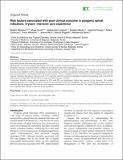Files in this item
Risk factors associated with poor clinical outcome in pyogenic spinal infections : 5-years’ intensive care experience
Item metadata
| dc.contributor.author | Milosevic, Branko | |
| dc.contributor.author | Cevik, Muge | |
| dc.contributor.author | Urosevic, Aleksandar | |
| dc.contributor.author | Nikolic, Natasa | |
| dc.contributor.author | Poluga, Jasmina | |
| dc.contributor.author | Jovanovic, Milica | |
| dc.contributor.author | Milosevic, Ivana | |
| dc.contributor.author | Micic, Jelena | |
| dc.contributor.author | Paglietti, Bianca | |
| dc.contributor.author | Barac, Aleksandra | |
| dc.date.accessioned | 2020-02-18T17:30:02Z | |
| dc.date.available | 2020-02-18T17:30:02Z | |
| dc.date.issued | 2020-01-31 | |
| dc.identifier | 266411020 | |
| dc.identifier | 70080ed4-34ad-4560-a83e-20fe81bd06c0 | |
| dc.identifier | 85079135647 | |
| dc.identifier | 000512957400005 | |
| dc.identifier.citation | Milosevic , B , Cevik , M , Urosevic , A , Nikolic , N , Poluga , J , Jovanovic , M , Milosevic , I , Micic , J , Paglietti , B & Barac , A 2020 , ' Risk factors associated with poor clinical outcome in pyogenic spinal infections : 5-years’ intensive care experience ' , Journal of Infection in Developing Countries , vol. 14 , no. 01 , pp. 36-41 . https://doi.org/10.3855/jidc.12260 | en |
| dc.identifier.issn | 2036-6590 | |
| dc.identifier.other | ORCID: /0000-0003-1133-3874/work/69029546 | |
| dc.identifier.uri | https://hdl.handle.net/10023/19492 | |
| dc.description.abstract | Introduction: Management of pyogenic spinal infections (PSI) after the development of neurological deficit has not been specifically addressed in the literature. We aimed to describe real-life clinical outcomes of PSI in patients admitted to an intensive care unit with neurological deficit and identify factors associated with good prognosis. Methodology: Consecutive patients admitted to ICU with a possible diagnosis of spinal infection over five years’ period were included. Descriptive statistics were performed to examine the demographics and clinical parameters. Results: The majority (71%) of patients were male. The mean age was 57.4 years (27-79), and 71% were > 50 years old. At least one underlying risk factor was identified in 68% of the patients; the most common comorbidity was diabetes mellitus (DM). All patients have presented with fever accompanied by a neurological deficit (86%) and back pain (79%). A complete recovery was achieved in 25% of patients. However, the majority of patients had adverse outcomes with 21.4% mortality, and 43% remaining neurological sequelae. Increased age with a cut-off of 65 years and pre-existing DM were identified as being associated with poor outcome. Conclusion: Mortality among patients admitted to ICU with PSI was significantly higher than reported in the literature. The residual neurological deficit was common, one-third of patients had remaining neurological sequelae, and only one-fourth had complete recovery. Increased age and background DM were the most important determinants of poor clinical outcome. The impact of DM appears to be much more important than currently recognised in this population. | |
| dc.format.extent | 6 | |
| dc.format.extent | 804218 | |
| dc.language.iso | eng | |
| dc.relation.ispartof | Journal of Infection in Developing Countries | en |
| dc.subject | Discitis | en |
| dc.subject | Pyogenic | en |
| dc.subject | Spinal infections | en |
| dc.subject | Spondylodiscitis | en |
| dc.subject | Vertebral infections | en |
| dc.subject | QR355 Virology | en |
| dc.subject | Microbiology | en |
| dc.subject | Parasitology | en |
| dc.subject | Virology | en |
| dc.subject | Infectious Diseases | en |
| dc.subject | E-DAS | en |
| dc.subject | SDG 3 - Good Health and Well-being | en |
| dc.subject.lcc | QR355 | en |
| dc.title | Risk factors associated with poor clinical outcome in pyogenic spinal infections : 5-years’ intensive care experience | en |
| dc.type | Journal article | en |
| dc.contributor.institution | University of St Andrews. School of Medicine | en |
| dc.identifier.doi | https://doi.org/10.3855/jidc.12260 | |
| dc.description.status | Peer reviewed | en |
This item appears in the following Collection(s)
Items in the St Andrews Research Repository are protected by copyright, with all rights reserved, unless otherwise indicated.

